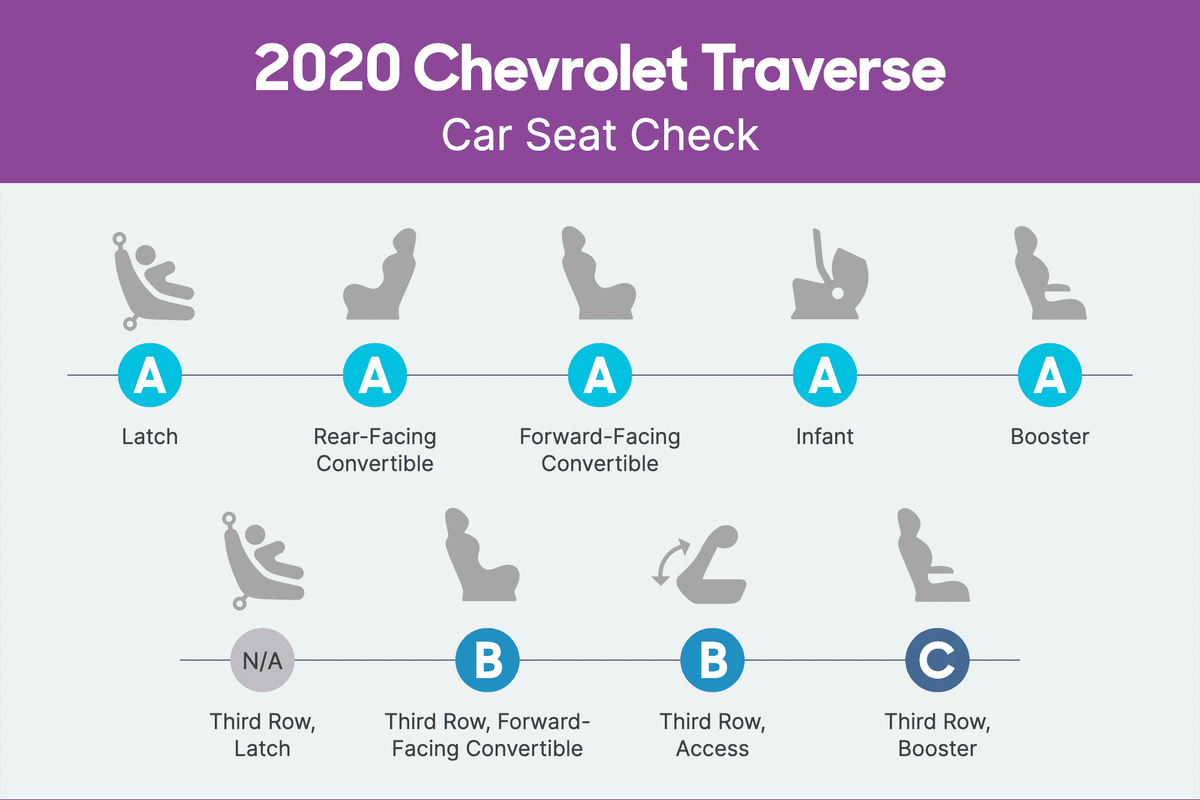How Do Car Seats Fit in a 2020 Chevrolet Traverse?


Editor’s note: This Car Seat Check was written in September 2018 about the 2018 Chevrolet Traverse. Little of substance has changed with this year’s model. See what’s new for 2020 or check out a side-by-side comparison of the model years.
The verdict: Chevrolet’s redesigned Traverse three-row SUV is one of the automaker’s largest people movers since the Bow-Tie brand no longer makes a minivan. When those “people” are kids, caregivers will find that the 2018 Traverse’s roomier second row is very car-seat-friendly — but its third row needs work. For this Car Seat Check, we tested a seven-passenger model with second-row captain’s chairs and a third-row bench seat.
Does it fit three car seats? No
Take a look at how the Latch system and each car seat scored below in our Car Seat Check of the 2020 Chevrolet Traverse.
Related: Search Car Seat Checks
- ${price_badge()}
- ${battery_badge()}${ev_report_link()}
- ${hot_car_badge()}
- ${award_badge()}
- ${cpo_badge()}
${price_badge_description}
The EV Battery Rating is based on this vehicle's current expected range relative to the vehicles expected range when new. ${battery_badge_text}
Certified cars are manufacturer warrantied and typically go through a rigorous multi-point inspection.
This car is likely to sell soon based on the price, features, and condition.
${award_blurb}
${award_two_blurb}
Shop the 2020 Chevrolet Traverse near you


A Grade
- Latch: The two sets of lower anchors are partially exposed for easy connection. The two top tether anchors sit a third of the way down the seatbacks and are also easy to access.
- Infant: Easy Latch anchors and good fit; we did not need to move the front passenger seat forward.
- Rear-facing convertible: Easy Latch connection and good fit; we did not need to move the front passenger seat forward.
- Forward-facing convertible: In the second row, installing the convertible was easy thanks to accessible Latch anchors. After raising the head restraint, the convertible fit well.
- Booster: In the second row, the booster fit well after raising the head restraint. The second row has stable buckles, which should make it easier for kids to buckle up independently.
B Grade
- Third-row access: The pass-through opening is narrow, as is the opening behind the driver’s side captain’s chair. On the passenger side, the opening is larger and the seat raises up and moves far forward at the pull of the lever. This handy feature wasn’t on the driver’s side.
- Third-row forward-facing convertible: Since there are no lower Latch anchors in the third row, we installed the seat with the seat belt. There are three clearly marked top tether anchors halfway down the seatback. The fixed head restraint means the convertible’s back isn’t flush with the car’s seatback.
C Grade
- Third-row booster: The fixed head restraint means the booster’s back isn’t flush with the car’s seatback. Also, the third row’s floppy buckles might make it tough for kids to buckle up independently.
About Cars.com’s Car Seat Checks
Editors Jennifer Geiger, Jennifer Newman and Matt Schmitz are certified child safety seat installation technicians.
For the Car Seat Check, we use a Graco SnugRide Classic Connect 30 infant-safety seat, a Britax Marathon convertible seat and Graco TurboBooster seat. The front seats are adjusted for a 6-foot driver and a shorter passenger. The three child seats are installed in the second row. The booster seat sits behind the driver’s seat, and the infant and convertible seats are installed behind the front passenger seat.
We also install the forward-facing convertible in the second row’s middle seat with the booster and infant seat in the outboard seats to see if three car seats will fit; a child sitting in the booster seat must be able to reach the seat belt buckle. If there’s a third row, we install the booster seat and a forward-facing convertible. Learn more about how we conduct our Car Seat Checks.
Parents should also remember that they can use the Latch system or a seat belt to install a car seat, and that Latch anchors have a weight limit of 65 pounds, including the weight of the child and the weight of the seat itself.
Cars.com’s Editorial department is your source for automotive news and reviews. In line with Cars.com’s long-standing ethics policy, editors and reviewers don’t accept gifts or free trips from automakers. The Editorial department is independent of Cars.com’s advertising, sales and sponsored content departments.

News Editor Jennifer Geiger joined the automotive industry in 2003, much to the delight of her Corvette-obsessed dad. Jennifer is an expert reviewer, certified car-seat technician and mom of three. She wears a lot of hats — many of them while driving a minivan.
Featured stories




